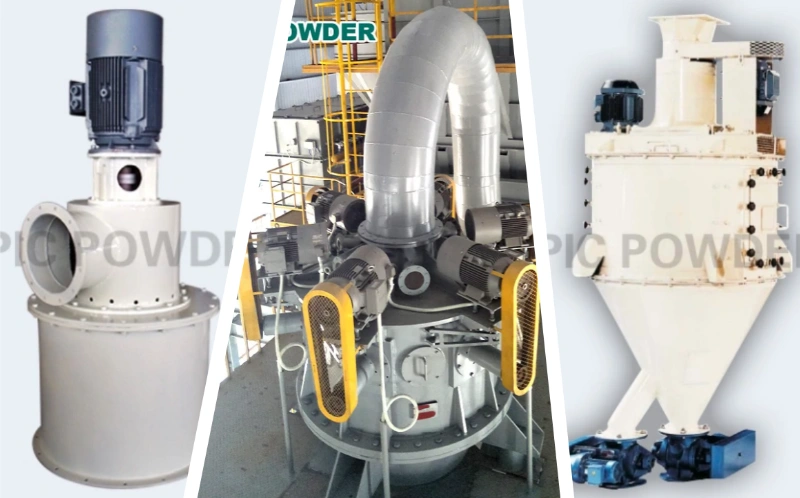Uneven particle size distribution can lower product quality, cause customer complaints, and increase production costs. An air classifier provides an efficient solution for precise powder classification and particle size control.
An air classifier is a device that separates fine particles from coarse ones in a dry powder system based on particle size, shape, and density. It works by introducing material into a high-speed air stream — heavier particles fall due to centrifugal force, while lighter particles are carried away with the airflow.
Keep reading to learn how air classifiers work and how to choose the right model for your production needs.

What Is an Air Classifier?
Air classifiers are key equipment in powder processing, efficiently separating fine particles from coarse materials to ensure the desired particle size distribution.
An air classifier uses a combination of airflow and centrifugal force to separate dry powders by size and density — without using screens or filters. This ensures precise classification, higher product uniformity, and consistent performance.
Different air classifier designs meet various processing requirements across industries such as minerals, chemicals, pharmaceuticals, and food. Understanding their structure helps select the best system for your application.
Learn more about Epic Powder’s Air Classifier and its advanced design.
How Does an Air Classifier Work?
Air classifiers rely on aerodynamic and centrifugal forces to achieve precise separation. The material is fed into a rotating classification chamber, where the high-speed rotor creates a strong air vortex. Heavier particles are pushed outward and fall, while lighter particles are carried away by airflow to the collector.
The system’s main components include a classifier wheel, rotor–stator assembly, classification chamber, and collection system. By adjusting rotor speed and airflow, the operator can precisely control the “cut point” — the particle size at which separation occurs.
For consistent powder separation and precise classification, explore Epic Powder’s Air Classifier systems.
What Are the Different Types of Air Classifiers?
Air classifiers come in several types, each designed for specific applications and fineness requirements.
1. Static Air Classifier – No moving parts; uses airflow patterns for coarse-fine separation.
2. Dynamic Air Classifier – Incorporates a rotating wheel for more accurate and adjustable cut points.
3. Turbo Air Classifier – Features a high-speed rotor for fine and ultrafine classification.
Selecting the right design depends on required particle fineness, capacity, and energy efficiency.
Learn how our impact mill can be integrated with air classifiers for optimal performance.
What Is an Air Classifier Mill?

An air classifier mill combines grinding and classification in one compact system. It simultaneously reduces particle size and classifies powder to produce fine, uniform materials in a single process step.
In operation, materials are ground by impact and friction, then classified by the integrated air classifier. Fine particles are collected as product, while coarse particles return for further grinding.
This system is widely used in mineral, chemical, and pharmaceutical powder production for high-efficiency fine grinding and classification.
What Are the Applications of Air Classifiers?
Air classifiers are essential in industries that require precise control of powder fineness for consistent product quality and performance.
They are commonly used in:
- Mineral processing: classification of calcium carbonate, talc, silica, graphite, and more.
- Chemical industries: separation of catalysts, pigments, and fillers.
- Pharmaceuticals: ensuring uniform particle size of active ingredients.
- Food industries: processing starch, protein powders, and food additives.
For ultrafine powder processing, discover Epic Powder’s jet mill and air classifier integration solutions.
What Are the Benefits of Using an Air Classifier?
Using an air classifier offers multiple advantages:
- Precise particle size control for consistent product quality.
- Improved production efficiency and reduced reprocessing.
- Energy-efficient design that lowers operating costs.
- Adaptability for handling various materials in one system.
- Clean, continuous operation for stable and reliable production.

Why Choose Epic Powder‘s Air Classifier?
Selecting the right air classifier is essential for achieving stable production, consistent product quality, and cost-effective operation.
Epic Powder’s Air Classifier features an advanced rotor system and precise, adjustable cut points. It offers high classification efficiency and accurate particle size control. The system provides reliable performance and long-term stability. Its optimized aerodynamic design matches the quality of leading Japanese and German models. However, it delivers this performance at a more competitive cost.
Epic Powder’s air classifiers integrate seamlessly with a wide range of grinding systems.
They are widely used in mineral, chemical, pharmaceutical, and food industries. Each system provides efficient and precise powder classification for various applications. Partner with Epic Powder to customize your air classification solution. Achieve uniform, high-quality powder products with improved efficiency and lower operating costs.

“Thanks for reading. I hope my article helps. Please leave a comment down below. You may also contact Zelda online customer representative for any further inquiries.”
— Posted By Emily Chen
